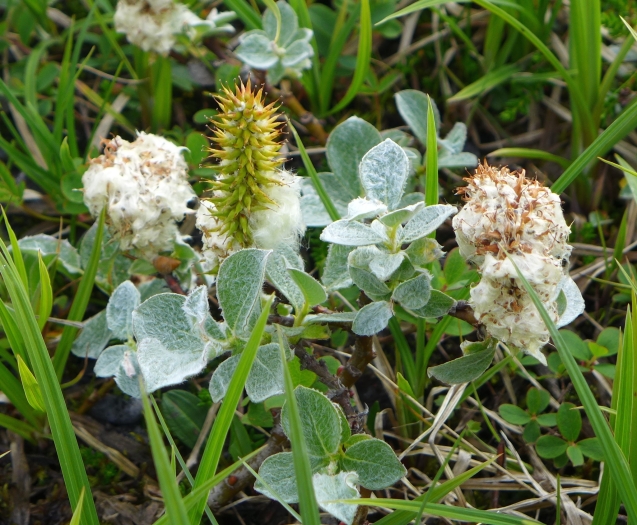Woolly Willow
(Salix lanata)
Woolly Willow (Salix lanata)
/
/

© icosahedron
CC BY 4.0
Image By:
© icosahedron
Recorded By:
Copyright:
CC BY 4.0
Copyright Notice:
Photo by: © icosahedron | License Type: CC BY 4.0 | License URL: http://creativecommons.org/licenses/by/4.0/ | Uploader: icosahedron | Publisher: iNaturalist |

























Estimated Native Range
Summary
Salix lanata, commonly known as Woolly Willow, is a deciduous shrub native to subarctic regions, including Iceland, the Faeroe Islands, Finland, eastern Siberia, and localized areas in Scotland. It is typically found in tundra and alpine environments, often on rocky mountain sides, where it contributes to the unique ecology of these high-elevation landscapes. Woolly Willow rarely exceeds 39 inches in height and 59 inches in width, forming a low, dense, and many-branched silhouette. The young twigs are covered in hairs, which mature to a hairless, brown state. Its distinctive leaves are grey-green, ovate, and can grow up to 3 inches long, with a characteristic silvery-grey woolly texture. Male and female catkins, which are the flowers of the willow, appear in summer on separate plants, with the female catkins being densely hairy.
The Woolly Willow is valued for its hardiness and compact growth habit, making it an excellent choice for rock gardens, alpine collections, and as a low-maintenance shrub in cold climates. It has earned the Royal Horticultural Society’s Award of Garden Merit for these qualities. In cultivation, it requires full sun to part shade, well-drained soil, and can tolerate a range of soil types, including rocky substrates. While it is generally low-maintenance, it can be susceptible to willow scab and other fungal diseases. It is also important to note that, like many willows, Salix lanata can be prone to root rot if planted in poorly drained soils.CC BY-SA 4.0
The Woolly Willow is valued for its hardiness and compact growth habit, making it an excellent choice for rock gardens, alpine collections, and as a low-maintenance shrub in cold climates. It has earned the Royal Horticultural Society’s Award of Garden Merit for these qualities. In cultivation, it requires full sun to part shade, well-drained soil, and can tolerate a range of soil types, including rocky substrates. While it is generally low-maintenance, it can be susceptible to willow scab and other fungal diseases. It is also important to note that, like many willows, Salix lanata can be prone to root rot if planted in poorly drained soils.CC BY-SA 4.0
Plant Description
- Plant Type: Shrub
- Height: 2-4 feet
- Width: 4-6 feet
- Growth Rate: Moderate
- Flower Color: N/A
- Flowering Season: Spring
- Leaf Retention: Deciduous
Growth Requirements
- Sun: Full Sun
- Water: High
- Drainage: Medium
Common Uses
Border Plant, Erosion Control, Low Maintenance, Water Garden
Natural Habitat
Native to subarctic tundra and alpine environments
Other Names
Common Names: Woolly Willow, Downy Willow, Ullvier, Vilges Syeedg, Felt Leaf Willow
Scientific Names: , Salix lanata, Diplima chrysantha, Salix americana, Salix caprea, Salix chrysantha, Salix chrysanthos, Salix confusa, Salix depressa, Salix glandulifera
GBIF Accepted Name: